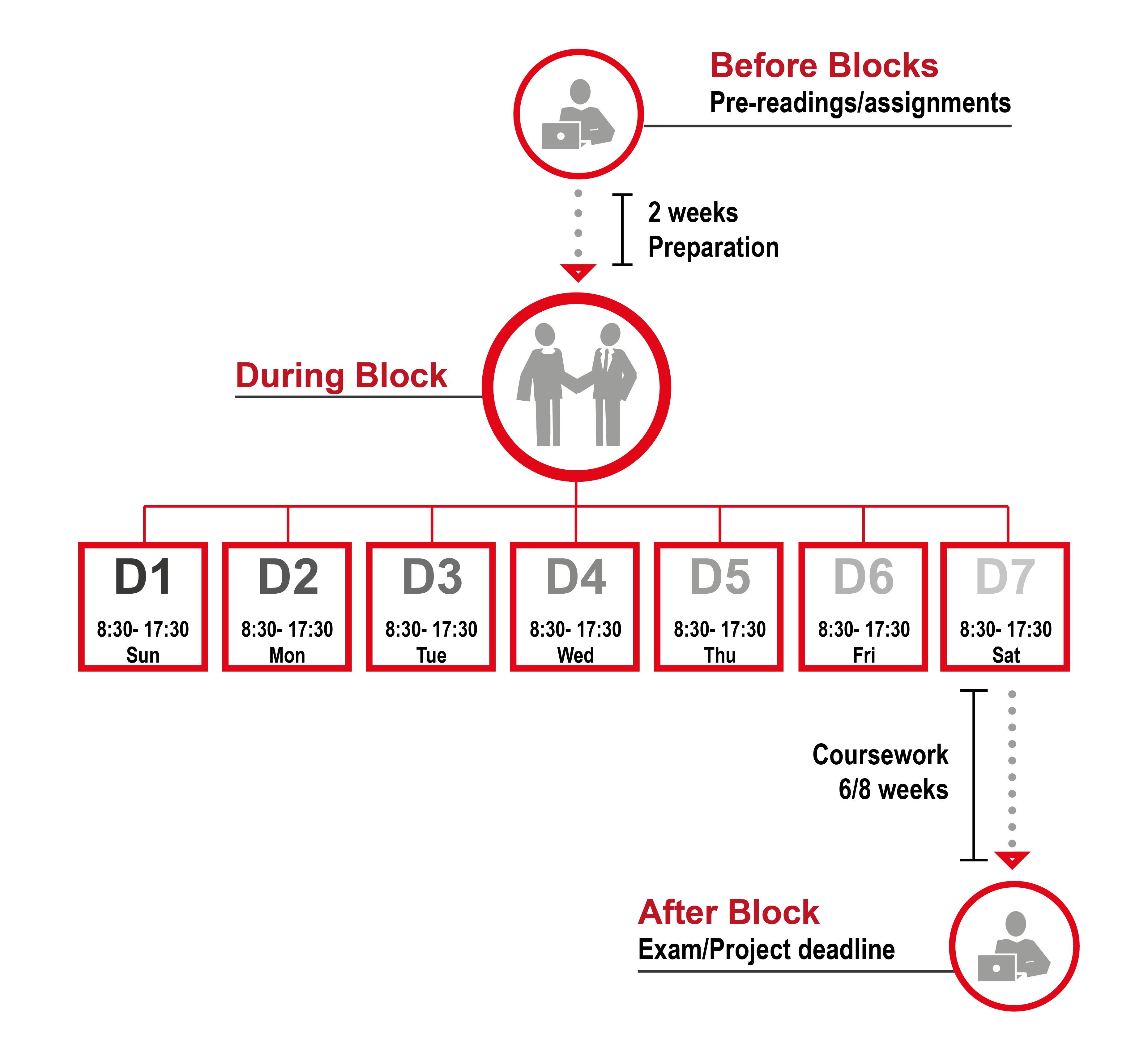![]()
![]()
![]()
Combine the academic excellence of the MAS with the flexibility to choose the most relevant courses for your professional development.
A Tailored Program in Humanitarian Logistics and Management gives the following option:
DAS | 30 ECTS
Diploma of Advanced Studies in
Humanitarian Logistics and Management
Choose 3 of the 6 blocks corresponding to 3 weeks of study.

PROGRAM STRUCTURE
Face-to-face instruction
Courses are interactive. Lectures are complemented by games, simulations, case studies, and group work. Participants actively contribute to classroom discussions, adding their practical know-how to academic theory.
Preparation
Between the study blocks, participants will work individually or in small groups on different projects designed to allow participants to put into practice what they have learned in class.
Exams
Each one-week block is followed by final exams and assignments which participants work on in their own time and deliver online. Exams are administered online using the Moodle e-learning platform.


FULL PROGRAM CONTENT
The curriculum is delivered across courses with expert faculty from all over the world.
Attend 3 blocks of your choice to receive a Diploma of Advanced Studies in Humanitarian Logistics and Management (DASHLM).
_____________
Block 1
▼ Introduction to Humanitarian Action
The course aims at familiarizing the master's participants with the environment in which international humanitarian action takes place, as well as with the range of humanitarian institutions and their relations with various categories of stakeholders.
Objectives
 Provide an overview of the basic concepts of humanitarian action and its relations with international development cooperation, a germane policy instrument;
Provide an overview of the basic concepts of humanitarian action and its relations with international development cooperation, a germane policy instrument;
 Present and discuss developments and trends in the world society, notably armed violence, and their humanitarian consequences;
Present and discuss developments and trends in the world society, notably armed violence, and their humanitarian consequences;
 Analyze the international response to humanitarian crises and the architecture of humanitarian action (overview and typology of actors);
Analyze the international response to humanitarian crises and the architecture of humanitarian action (overview and typology of actors);
 Familiarize the participants with some of the main issues and challenges that presently confront humanitarian action and humanitarian actors.
Familiarize the participants with some of the main issues and challenges that presently confront humanitarian action and humanitarian actors.
Topics
 Humanitarian action;
Humanitarian action;
 The world under stress;
The world under stress;
 Global governance and humanitarian actors;
Global governance and humanitarian actors;
 The UN response to crises;
The UN response to crises;
 Relations of humanitarian actors with political and military actors;
Relations of humanitarian actors with political and military actors;
 From emergency to development: Humanitarian action and international development cooperation;
From emergency to development: Humanitarian action and international development cooperation;
 Humanitarian funding;
Humanitarian funding;
 Relations of actors among themselves and relations with national/local institutions and the beneficiaries.
Relations of actors among themselves and relations with national/local institutions and the beneficiaries.

|
Jacques Forster |
▼ Process Management and Lean Six Sigma
Managing and improving processes that create and deliver an organization’s primary products and services is critically important for the long-term survival and success of all organizations. Accordingly, this course will expose you to the principles of Process Management which will help you understand, analyze, improve and manage processes in Humanitarian Logistics. Two major approaches for process improvement emerged separately in the 20th century and have come to be known as “Lean” and “Six Sigma” methodologies. Lean improvements focus on process speed and waste removal, while Six Sigma focuses on the removal of process defects for quality improvements and the reduction of process variability.
At the end of the course, you will earn a Lean Six Sigma Green Belt certificate.
Objectives
 To introduce you to the concepts, tools, and techniques of Process Management using Lean Six Sigma that are particularly useful in successfully managing processes commonly encountered in Humanitarian Logistics;
To introduce you to the concepts, tools, and techniques of Process Management using Lean Six Sigma that are particularly useful in successfully managing processes commonly encountered in Humanitarian Logistics;
 Adopt the process management viewpoint to understand humanitarian logistics processes and identify their performance measures in terms of cost, quality, speed, service, and flexibility. Define, describe, and utilize concepts fundamental to process analysis;
Adopt the process management viewpoint to understand humanitarian logistics processes and identify their performance measures in terms of cost, quality, speed, service, and flexibility. Define, describe, and utilize concepts fundamental to process analysis;
 Analyze complex processes using suitable process analysis techniques and make sound recommendations for improving processes;
Analyze complex processes using suitable process analysis techniques and make sound recommendations for improving processes;
 Develop an understanding of the Lean Six Sigma tools and techniques, including the DMAIC methodology.
Develop an understanding of the Lean Six Sigma tools and techniques, including the DMAIC methodology.
Topics
 Overview of Lean Six Sigma;
Overview of Lean Six Sigma;
 Business Process Management: Process Flow Chart, Cycle Time, Takt Time, Capacity, Little's Law, Economies of Scale, Inventory Management;
Business Process Management: Process Flow Chart, Cycle Time, Takt Time, Capacity, Little's Law, Economies of Scale, Inventory Management;
 Lean Six Sigma Tools and Techniques: SIPOC, Voice of Customer, Process Mapping, Value Analysis, Fishbone Chart, Benchmarking, Poka Yoke, Matching Demand and Supply, Improving Service Quality, Risk Analysis - FMEA, Prototype and Pilot Testing, Stakeholder Analysis, 5 S Systems, Rapid Improvement Events, Process Control Charts.
Lean Six Sigma Tools and Techniques: SIPOC, Voice of Customer, Process Mapping, Value Analysis, Fishbone Chart, Benchmarking, Poka Yoke, Matching Demand and Supply, Improving Service Quality, Risk Analysis - FMEA, Prototype and Pilot Testing, Stakeholder Analysis, 5 S Systems, Rapid Improvement Events, Process Control Charts.
Lean Six Sigma Green Belt
 After successfully completing the course, a certificate for having completed the educational requirements of LSS Green Belt will be awarded. The full-fledged Green Belt certificate will be awarded when the student successfully completes a LSS Green Belt project under the guidance of a faculty instructor.
After successfully completing the course, a certificate for having completed the educational requirements of LSS Green Belt will be awarded. The full-fledged Green Belt certificate will be awarded when the student successfully completes a LSS Green Belt project under the guidance of a faculty instructor.

|
Uday Apte |
_____________
Block 2
▼ Project Management Principles
The objective of the project management teaching module is to cover the basic principles and advanced methods for managing complex projects. Examples of complex projects in humanitarian logistics are the establishment of logistics infrastructures such as distribution centers in various parts of the world or the implementation of new information technology and communications systems to improve ongoing operations and disaster response.
Objectives
 The overall objective of this course is to introduce basic principles, methods, and tools for project management in a realistic context, such that they can be taken back to the workplace to improve your ability to manage complex development projects;
The overall objective of this course is to introduce basic principles, methods, and tools for project management in a realistic context, such that they can be taken back to the workplace to improve your ability to manage complex development projects;
 Understand the theory underlying the methods and tools of project management;
Understand the theory underlying the methods and tools of project management;
 Be able to apply the methods and tools and understand their limitations;
Be able to apply the methods and tools and understand their limitations;
 Obtain an appreciation for organizational and human aspects in (1) Project Organizations and (2) Project Manager soft skills and typical profiles.
Obtain an appreciation for organizational and human aspects in (1) Project Organizations and (2) Project Manager soft skills and typical profiles.
Topics
 Work Breakdown Structures (WBS);
Work Breakdown Structures (WBS);
 Critical Path Method (CPM);
Critical Path Method (CPM);
 Program Evaluation and Review Technique (PERT);
Program Evaluation and Review Technique (PERT);
 Workflow and Design Structure Matrices (DSM);
Workflow and Design Structure Matrices (DSM);
 Budgeting and Earned Value Management;
Budgeting and Earned Value Management;
 Project Risk Management;
Project Risk Management;
 Human and Organizational Aspects of Project Management;
Human and Organizational Aspects of Project Management;
 Principles of Project Management Summary.
Principles of Project Management Summary.

|
Afreen Siddiqi |

|
Olivier L. de Weck |
The course covers the operational and strategic aspects of all the elements or components of the logistics process from a supply chain management perspective.
Objectives
 Introduce the building blocks of supply chain management from both practical and analytical perspectives;
Introduce the building blocks of supply chain management from both practical and analytical perspectives;
 Develop the basic logistics concepts and frameworks for decision-making in supply chain management settings;
Develop the basic logistics concepts and frameworks for decision-making in supply chain management settings;
 It includes an introduction to supply chain management, supply chain elements, supply chain integration and some strategic consideration in supply chain management.
It includes an introduction to supply chain management, supply chain elements, supply chain integration and some strategic consideration in supply chain management.
Topics
 Introduction and Customer Service;
Introduction and Customer Service;
 Sourcing and Contract Management;
Sourcing and Contract Management;
 Warehousing and Inventory;
Warehousing and Inventory;
 Reverse Logistics and Transportation;
Reverse Logistics and Transportation;
 Operations and Logistics Information Systems;
Operations and Logistics Information Systems;
 Logistics Channels and Network Design;
Logistics Channels and Network Design;
 Alignment of Supply and Demand and Management Strategies;
Alignment of Supply and Demand and Management Strategies;
 Global Logistics and Risk Management.
Global Logistics and Risk Management.

|
Gerard de Villiers |
Humanitarian logistics require the movement of goods to disaster and crisis regions around the globe, often under time pressure and other challenging conditions including maintaining sustainability standards. The success of these supply chains will depend on transportation choices and the design of its distribution network. This class will look at these choices and practice the design of a humanitarian transportation network to serve typical humanitarian scenarios.
Objectives
 Understand the role of transportation in the humanitarian supply chain including infrastructure, policies, and conditions on the ground
Understand the role of transportation in the humanitarian supply chain including infrastructure, policies, and conditions on the ground
 Distinguish between strategic (long-term), tactical (mid-term), and operational (short-term) levels of decision-making in transportation management
Distinguish between strategic (long-term), tactical (mid-term), and operational (short-term) levels of decision-making in transportation management
 Evaluate the strengths and weaknesses of different modes of transportation and various transportation network design options including trade-offs and conflicting objectives
Evaluate the strengths and weaknesses of different modes of transportation and various transportation network design options including trade-offs and conflicting objectives
 Recognize that transportation must support strategic priorities like cost, responsiveness, access, precision, and environmental sustainability
Recognize that transportation must support strategic priorities like cost, responsiveness, access, precision, and environmental sustainability
Topics
 Humanitarian logistics
Humanitarian logistics
 Sustainability
Sustainability
 Transportation Networks;
Transportation Networks;
 Supply Chain
Supply Chain
 Managerial best practice
Managerial best practice

|
Bublu S. Thakur-Weigold |
Procurement is a critical and challenging activity in humanitarian logistics and supply management. First, 65 percent of relief operation costs in humanitarian operations are estimated to be related to procurement. Second, procurement requires a systematic approach considering both the short- and long-term impact of purchasing decisions on the affected area. Third, multiple criteria such as cost, quality, delivery time, supplier reliability, or local supply capacity should be considered in procurement decisions. Fourth, new aspects such as digitalisation and environmental sustainability of procurement are also increasingly valued and expected by donors. Therefore, specific skills and capabilities are required from professionals working in the area of procurement in a humanitarian setting. This course intends to provide students the required basic knowledge and capabilities to cope with the competence requirements for procurement experts in humanitarian supply chain.
Objectives
 Understand the significance and basic concepts in the area of procurement management
Understand the significance and basic concepts in the area of procurement management
 Know the approaches and models, including digitalisation, to support procurement of different types of goods and services
Know the approaches and models, including digitalisation, to support procurement of different types of goods and services
 Identify special characteristics of challenges and risks in procurement in humanitarian logistics, and ways to handle and mitigate them
Identify special characteristics of challenges and risks in procurement in humanitarian logistics, and ways to handle and mitigate them
 Integrate environmental sustainability conditions into the procurement process
Integrate environmental sustainability conditions into the procurement process
Topics
 Supply management
Supply management
 Humanitarian logistics
Humanitarian logistics
 Purchase
Purchase
 Cost, quality and delivery time
Cost, quality and delivery time
 Supplier reliability
Supplier reliability
 Local supply capacity
Local supply capacity

|
Mohammad Moshtari |
_____________
Block 3
▼ Project Strategy & Scenario Planning
This course examines concepts, tools, and a method for conducting scenario analysis, defining strategic project objectives and project strategy, and allocating resources to a portfolio of strategic projects. Historically, smart managers have frequently made wrong assumptions about the future with great certainty. Scenario planning is a disciplined method for imagining possible futures that is designed to overcome common decision-making errors such as overconfidence and the tendency to look only for confirming evidence of current beliefs.
Once managers have developed a more robust view of the future, they can more effectively define sets of projects to build future organizational competencies. This course will also examine project objective definition and present heuristics for project strategy and execution in complex and uncertain environments.
Objectives
 Construct scenarios scalable to any organizational need;
Construct scenarios scalable to any organizational need;
 Define a strategic project’s objectives and strategy;
Define a strategic project’s objectives and strategy;
 Evaluate alternative projects for resource allocation.
Evaluate alternative projects for resource allocation.
Topics
 Focus Question, Time Frame, Hexagons or Affinity Diagram;
Focus Question, Time Frame, Hexagons or Affinity Diagram;
 Stakeholder list, Stakeholder x Issues Matrix;
Stakeholder list, Stakeholder x Issues Matrix;
 Behavior-over-time Chart, Causal-loop Diagram;
Behavior-over-time Chart, Causal-loop Diagram;
 Uncertainties, Possible Outcomes, Uncertainty Correlation Matrix;
Uncertainties, Possible Outcomes, Uncertainty Correlation Matrix;
 3 ways to construct initial scenarios;
3 ways to construct initial scenarios;
 Learning scenarios, researching scenarios;
Learning scenarios, researching scenarios;
 Early indicators, Scenario Matrix;
Early indicators, Scenario Matrix;
 Analytical Prioritization Matrix.
Analytical Prioritization Matrix.

|
Don Greer |
▼ Surveys: how to collect data with questionnaires and how to assign codes to it
This course aims at providing students with the knowledge of creating questionnaires for structured interviews and how to transfer the responses into a data set that is analyzable with statistical methods. Thus, we will talk about, e.g., filter questions, multiple choice questions, and ranking questions in questionnaires and many other aspects of questionnaires. In a further step, it will be shown, how the responses of the interviewees can be transferred into a meaningful data set. In other words: one has to assign codes to the answers given by the respondents. A lot of work connected to surveys and assigning codes to responses is nowadays taken over by online softwares, like e.g. Qualtrics or Survey Monkey. I will briefly introduce one of these survey softwares. However, since it is absolutely crucial that the students understand how a correct data set is constructed from structured interviews, the course will concentrate on the “do-it-yourself” of data set creation.
Topics
 Questionnaire construction;
Questionnaire construction;
 Types of questions in a questionnaire;
Types of questions in a questionnaire;
 Assigning codes to answers.
Assigning codes to answers.

|
Nikolaus Beck |
▼ Practical Research Methods (Qualitative)
This course explores qualitative research methodology and its application in business and management research. In particular, the purpose of this course is to equip students to critically design, conduct, and evaluate qualitative research projects undertaking case study research and interviews. The course therefore aims to answer the following question – How can the researcher go from the initial research questions to the findings by using case study research and interviews. The course therefore entails traditional meetings involving theoretical lectures and practical exercises. To make sure the students are familiarized with the concrete application of qualitative methods, part of the course would also involve them working on a hypothetical research project (in groups).
Topics
 Qualitative research;
Qualitative research;
 Case study research;
Case study research;
 Qualitative interviews.
Qualitative interviews.
Objectives
 Describe the common features of case study research and qualitative interviews;
Describe the common features of case study research and qualitative interviews;
 Acquire knowledge of the research process involved in basic case study research and qualitative interview studies;
Acquire knowledge of the research process involved in basic case study research and qualitative interview studies;
 Acquire knowledge of the quality considerations involved in a basic case study research and qualitative interviews;
Acquire knowledge of the quality considerations involved in a basic case study research and qualitative interviews;
 Acquire knowledge of the elements involved in a basic case study and qualitative interview study report.
Acquire knowledge of the elements involved in a basic case study and qualitative interview study report.

|
Lakshmi Balachandran Nair |
Strategy is a loaded concept, which suggests profit maximization, cost-cutting and slick marketing – questions that may seem far from the relevant to non-profit organizations. In this course we draw on the extensive knowledge there is on strategy and strategic analysis, but we put it to use in the context of non-profit organizations. While some of the concepts are readily transferable from a for-profit to a non-profit context, some require more care and afterthought to be translated in a useful manner.
Objectives
 Articulate and/or critique your organization’s mission, vision, values and strategy (and demonstrated you understand the differences among these terms);
Articulate and/or critique your organization’s mission, vision, values and strategy (and demonstrated you understand the differences among these terms);
 Conduct stakeholder analyses for two of those objectives;
Conduct stakeholder analyses for two of those objectives;
 Analyze your organization’s external environments, including assessing possible consequences of current trends in the environment;
Analyze your organization’s external environments, including assessing possible consequences of current trends in the environment;
 Perform internal analyses of your organization, focusing on resources and capabilities; and
Perform internal analyses of your organization, focusing on resources and capabilities; and
 Made well-reasoned, actionable recommendations, informed by your analyses.
Made well-reasoned, actionable recommendations, informed by your analyses.
Topics
 The strategic plan that matters. “Planning” as orientation and integration. Why the process matters. Communication iterations and cycles for creating shared understanding;
The strategic plan that matters. “Planning” as orientation and integration. Why the process matters. Communication iterations and cycles for creating shared understanding;
 Missions, visions, and values. Strategic and financial objectives. Generic strategic approaches to organizational distinction;
Missions, visions, and values. Strategic and financial objectives. Generic strategic approaches to organizational distinction;
 Stakeholder analyses. Distinguishing between the donor environment and the beneficiary environment. Managing stakeholders to achieve organizational objectives;
Stakeholder analyses. Distinguishing between the donor environment and the beneficiary environment. Managing stakeholders to achieve organizational objectives;
 Applying Porter’s Five Forces analysis to the donor environment. Analysis of trends driving change in the operational environment;
Applying Porter’s Five Forces analysis to the donor environment. Analysis of trends driving change in the operational environment;
 Resources and capabilities. Assessing strategically valuable resources. Core and distinctive capabilities;
Resources and capabilities. Assessing strategically valuable resources. Core and distinctive capabilities;
 Comparing the resource view with the vision, mission, objectives, and strategy. Assessing the fit of internal resources with external environments to achieve objectives. Making strategic, actionable recommendations;
Comparing the resource view with the vision, mission, objectives, and strategy. Assessing the fit of internal resources with external environments to achieve objectives. Making strategic, actionable recommendations;
 Communication pacing. Visual works-in-process. The value of “bad drafts.” Creating action plans based on shared understanding.
Communication pacing. Visual works-in-process. The value of “bad drafts.” Creating action plans based on shared understanding.

|
Stefan Arora-Jonsson |
_____________
Block 4
This course introduces you to system dynamics modeling with an emphasis on supply chain management issues. You will learn to visualize supply chains and other systems in terms of the structures and policies that create dynamics and regulate performance.
Objectives
 Introduce students to the theory and practice of system dynamics;
Introduce students to the theory and practice of system dynamics;
 To provide a general framework for conceptualizing and understanding dynamics of any system;
To provide a general framework for conceptualizing and understanding dynamics of any system;
 To provide specific insight into the dynamics of supply chains and other structures such as epidemics and work-accomplishment;
To provide specific insight into the dynamics of supply chains and other structures such as epidemics and work-accomplishment;
 To improve students’ understanding of the ways in which system performance can be improved.
To improve students’ understanding of the ways in which system performance can be improved.
Topics
 To model is human;
To model is human;
 System Dynamics: A way to model;
System Dynamics: A way to model;
 Patterns of behavior;
Patterns of behavior;
 Patterns and Feedback loops;
Patterns and Feedback loops;
 ArchetypesStocks and flows;
ArchetypesStocks and flows;
 Supply chains.
Supply chains.

|
Jin Hines |
This course covers both financial and managerial accounting. Financial accounting primarily focuses on providing information to external stakeholders (such as shareholders and debt holders for for-profit firms and donors and stakeholders in non-profit organizations). Managerial accounting primarily focuses on providing information to internal parties, such as managers and executives.
The first part of this course will focus on financial accounting, which is often referred to as the language of business. Students will gain experience with the basic terminology and tools to prepare and read a set of financial statements from both for profit and non-profit providers. Financial accounting is like a language; students become more fluent with practice. The second part of the course explores the use of accounting information for internal planning and decision-making.
Objectives
 The main objective of the course is to equip you with the knowledge to understand, evaluate, and act upon the financial and non-financial reports used in managing modern firms. The emphasis in this course is very much on interpretation, evaluation, and decision making;
The main objective of the course is to equip you with the knowledge to understand, evaluate, and act upon the financial and non-financial reports used in managing modern firms. The emphasis in this course is very much on interpretation, evaluation, and decision making;
 Understand the mechanics of financial accounting;
Understand the mechanics of financial accounting;
 Acquire the basic language and tools to assess and communicate the impact of logistics on a firm’s financial performance;
Acquire the basic language and tools to assess and communicate the impact of logistics on a firm’s financial performance;
 Understand the various links between operating variables and financial performance;
Understand the various links between operating variables and financial performance;
 Be able to obtain relevant information from financial statements;
Be able to obtain relevant information from financial statements;
 Understand the difference between the various types of costs involved when assessing the impact of a decision.
Understand the difference between the various types of costs involved when assessing the impact of a decision.
Topics
 Introduction to Financial Reporting and Analysis: how cash accounting works; what is accrual accounting; understanding the Balance Sheet; understanding the Income Statement;
Introduction to Financial Reporting and Analysis: how cash accounting works; what is accrual accounting; understanding the Balance Sheet; understanding the Income Statement;
 Cash Flow Statement & Analysis: Introduction to the Cash Flow Statement; How does it differ from the Income Statement;
Cash Flow Statement & Analysis: Introduction to the Cash Flow Statement; How does it differ from the Income Statement;
 Financial and Inventory Related Ratios;
Financial and Inventory Related Ratios;
 Working Capital Requirements;
Working Capital Requirements;
 Profit vs Cash Flow. Sustainable Growth;
Profit vs Cash Flow. Sustainable Growth;
 Financials in the Value Chain;
Financials in the Value Chain;
 Introduction to Investment Decisions. Net Present Value;
Introduction to Investment Decisions. Net Present Value;
 Decisions at Capacity.
Decisions at Capacity.

|
Eric Nowak |
This course aims to familiarize students with statistical theory, tools, and methods required for business systems analysis and improvement, emphasizing their application in real life situations.
Objectives
 Introduce students to the principles of statistics and its applications to common humanitarian contexts;
Introduce students to the principles of statistics and its applications to common humanitarian contexts;
 Gain understanding of concepts in probability and statistics and their applications;
Gain understanding of concepts in probability and statistics and their applications;
 Gain understanding of statistical models and their applications;
Gain understanding of statistical models and their applications;
 Learn to use excel to address applied statistical problems.
Learn to use excel to address applied statistical problems.
Topics
 Descriptive Statistics;
Descriptive Statistics;
 Continuous Distributions;
Continuous Distributions;
 Sampling Distributions;
Sampling Distributions;
 Confidence Intervals;
Confidence Intervals;
 Hypothesis testing;
Hypothesis testing;
 Significance;
Significance;
 Linear Regression;
Linear Regression;
 Multiple Regression.
Multiple Regression.
|
Jost Reinhold |
Social innovations include ideas, concepts, processes and organizations that focus on societal needs. Social entrepreneurship can be understood as the process of identifying and starting a new business venture to address a pressing public and societal need.
This course starts by exposing students to pressing societal needs, then introduces them to the concepts and techniques associated with human-centered design for social innovation. Through a combination of methods, such as ideation and prototyping students learn to design robust ideas for social innovations.
Objectives
 Introduce students to the principles of social innovations;
Introduce students to the principles of social innovations;
 Adopt a Human Center Design (HCD) approach as a driving force to guide students through the different design process stages, such as discover, ideate and prototype;
Adopt a Human Center Design (HCD) approach as a driving force to guide students through the different design process stages, such as discover, ideate and prototype;
 Expose students to processes that would allow them to generate robust ideas for social innovations.
Expose students to processes that would allow them to generate robust ideas for social innovations.
Topics
 HCD approach & Discovery Phase;
HCD approach & Discovery Phase;
 Individual Local Challenges;
Individual Local Challenges;
 Ideation Phase;
Ideation Phase;
 Innovation Tournaments & Darwinator;
Innovation Tournaments & Darwinator;
 Innovation Tournament and Principles of Idea Screening;
Innovation Tournament and Principles of Idea Screening;
 Real-Win-Worth-it (RWW) criteria;
Real-Win-Worth-it (RWW) criteria;
 Idea Defense and Recombination;
Idea Defense and Recombination;
 Introduction to User Journey and Biases (The Fogg’s Principles);
Introduction to User Journey and Biases (The Fogg’s Principles);
 Build-measure-learn cycle and OODA loops;
Build-measure-learn cycle and OODA loops;
 External search;
External search;
 Prototype phase;
Prototype phase;
 Final pitch.
Final pitch.

|
Paulo Gonçalves |
_____________
Block 5
▼ Operations and Supply Chain Management
This course is designed to familiarize participants with advanced analytical models that can aid in making distribution and routing decisions such as: Where and when to procure? Where to store? How to transport? We will also focus on modeling and analyzing the trade-offs between cost and speed of delivery and the role of uncertainty.
Objectives
 To improve the participant's ability to analyze and assess various trade-offs present in managing distribution and routing of supplies and incorporate uncertainty in decision making.
To improve the participant's ability to analyze and assess various trade-offs present in managing distribution and routing of supplies and incorporate uncertainty in decision making.
Topics
 Network flows;
Network flows;
 Multi-commodity network flows;
Multi-commodity network flows;
 Networks over time;
Networks over time;
 Bottlenecks and trade-offs;
Bottlenecks and trade-offs;
 Role of uncertainty and decision trees Routing vehicles.
Role of uncertainty and decision trees Routing vehicles.

|
Julie Swann |

|
Özlem Ergun |
This course aims to familiarize mashlm participants with management science techniques for the analysis and improvement of humanitarian systems. The techniques, including linear and integer programming, and goal programming, will be illustrated through examples and case studies derived from humanitarian applications.
Objectives
 Introduce students to the principles and practices of management science models for the analysis and improvement of humanitarian systems;
Introduce students to the principles and practices of management science models for the analysis and improvement of humanitarian systems;
 To provide an analytical framework for modeling and improving processes and decisions in humanitarian contexts;
To provide an analytical framework for modeling and improving processes and decisions in humanitarian contexts;
 To convey an intuitive understanding of widely-used analytical techniques and their applications (e.g., Linear and Integer Programming);
To convey an intuitive understanding of widely-used analytical techniques and their applications (e.g., Linear and Integer Programming);
 To provide hands-on experience with implementing models learned in class using excel.
To provide hands-on experience with implementing models learned in class using excel.
Topics
 Linear Programming (LP) Applications: Budget allocation, scheduling, transportation, production planning, transshipment and general transportation problems, shortest path and max flow;
Linear Programming (LP) Applications: Budget allocation, scheduling, transportation, production planning, transshipment and general transportation problems, shortest path and max flow;
 Integer Programming Applications: Optimizing distribution of food aid with capacity constraints and losses, locating facilities to meet demand of beneficiaries, supply and demand constraints.
Integer Programming Applications: Optimizing distribution of food aid with capacity constraints and losses, locating facilities to meet demand of beneficiaries, supply and demand constraints.

|
Paulo Gonçalves |
▼ Crisis Information Management
Information Management is critical to support an evidence-based decision-making process that has the affected population at the forefront. This fundamental session will explore the main aspects for effective management of information in a humanitarian crisis.
Objectives
 To explain IM principles applied to the humanitarian environment and coordination structures;
To explain IM principles applied to the humanitarian environment and coordination structures;
 To explain principles and tools related to the development of an Information Management Strategy;
To explain principles and tools related to the development of an Information Management Strategy;
 To demonstrate practical skills to leverage geographic information with user-friendly, free tools available online;
To demonstrate practical skills to leverage geographic information with user-friendly, free tools available online;
 To demonstrate abilities to estimate populations through various techniques and to develop a Population Management Strategy;
To demonstrate abilities to estimate populations through various techniques and to develop a Population Management Strategy;
 To explain concepts of analysis in humanitarian situations and basic principles of visualization of information.
To explain concepts of analysis in humanitarian situations and basic principles of visualization of information.
Topics
 Information and Coordination;
Information and Coordination;
 Information Management Strategy Development;
Information Management Strategy Development;
 Geographic Information;
Geographic Information;
 Population Estimation;
Population Estimation;
 Analysis and Visualization.
Analysis and Visualization.
Simulation
 This pertains to Needs Assessment and Crisis Information Management. It is a scenario based practical exercise that will simulate a crisis and will require students to apply concepts and skills learn previously in the course.
This pertains to Needs Assessment and Crisis Information Management. It is a scenario based practical exercise that will simulate a crisis and will require students to apply concepts and skills learn previously in the course.

|
Andrew Alspach |
This session will cover the basic components of assessing needs in a humanitarian situation and analytical process to classify the severity of need.
Objectives
 Students can explain methodologies, processes, and planning related to assessing needs in a crisis environment;
Students can explain methodologies, processes, and planning related to assessing needs in a crisis environment;
 Students can demonstrate the application of methods to assign needs severity to an affected population.
Students can demonstrate the application of methods to assign needs severity to an affected population.
Topics
 Needs assessment fundamentals;
Needs assessment fundamentals;
 Analysis of the severity of needs.
Analysis of the severity of needs.

|
Andrew Alspach |
_____________
Block 6
▼ Simulation/Delivery of Humanitarian Assistance
The delivery of humanitarian assistance and, indeed, the significance of the term humanitarianism in today’s political climate, are increasingly under scrutiny. We are witnessing situations such as the Ebola crisis and ongoing conflicts in Syria and the Congo that increasingly challenge the ability of the humanitarian community to be of assistance to those in need. In addition, the increasingly important role of “outside” actors such as the military and the corporate sector, pose significant challenges to what has been long considered the domain of a loosely described humanitarian community.
Questions arise, such as what are the essential differences between humanitarian assistance and the direct provision of relief, or does it even matter? When does humanitarian assistance become part of the conflict, regardless of the intentions of the assistance providers? And finally, how meaningful is the generally accepted distinction between relief and development?
Objectives
 To provide students with background on the humanitarian system and the tools and approaches required to deal with the changing nature of humanitarian preparedness and response in the field and at headquarters.
To provide students with background on the humanitarian system and the tools and approaches required to deal with the changing nature of humanitarian preparedness and response in the field and at headquarters.
 A major question to be discussed is what is the future of humanitarian assistance? We will examine the concerns generated by the need for organizations to be accountable to a wide constituency, including beneficiaries, donors, the public, and the press.
A major question to be discussed is what is the future of humanitarian assistance? We will examine the concerns generated by the need for organizations to be accountable to a wide constituency, including beneficiaries, donors, the public, and the press.
Topics
 How does one evaluate donor views on achievable goals as opposed to those of the relief organization field director or the UN official in charge?;
How does one evaluate donor views on achievable goals as opposed to those of the relief organization field director or the UN official in charge?;
 What are the structural and operational imperatives and obstacles guiding decision making at theheadquarters and field level?;
What are the structural and operational imperatives and obstacles guiding decision making at theheadquarters and field level?;
 What are the links between data and program planning and operations?;
What are the links between data and program planning and operations?;
 How do issues of standards and accountability come into play in decision making?;
How do issues of standards and accountability come into play in decision making?;
 The realities of staff training and staff selection;
The realities of staff training and staff selection;
 Coordination as opposed to cooperation—an appraisal;
Coordination as opposed to cooperation—an appraisal;
 Civilian and military interaction—the changing relationship;
Civilian and military interaction—the changing relationship;
 Political factors in the delivery of assistance.
Political factors in the delivery of assistance.

|
Roy Williams |
This course aims to introduce and explore key elements of the theory and practice of disaster management, resilience and disaster risk reduction (DRR). With a core focus on vulnerability, participants will apply and critically review emergency-oriented approaches to risk, and compare and contrast these with developmentally-oriented understandings and tools. Models used in practice will be combined with practical tools and approaches including participatory assessment, negotiation, and social media.
Objectives
 Understand the linkages between development and emergency related concepts of risk, hazards, vulnerability, capacity, assets, governance and discrimination;
Understand the linkages between development and emergency related concepts of risk, hazards, vulnerability, capacity, assets, governance and discrimination;
 Critically review different approaches and tools used in practice;
Critically review different approaches and tools used in practice;
 Apply planning and analysis tools and approaches to different situations.
Apply planning and analysis tools and approaches to different situations.
Topics
 Pressure And Release (PAR) model and the cycle of disaster;
Pressure And Release (PAR) model and the cycle of disaster;
 Local to global chronic vulnerability;
Local to global chronic vulnerability;
 Disaster simulation;
Disaster simulation;
 Relief-recovery lessons - Philippines’ Typhoon Haiyan;
Relief-recovery lessons - Philippines’ Typhoon Haiyan;
 Livelihoods/resilience model as a people-centered approach for linking elements that determine community level risk;
Livelihoods/resilience model as a people-centered approach for linking elements that determine community level risk;
 Assessment tools for people-centred programme design - participatory rapid appraisal (PRA) techniques;
Assessment tools for people-centred programme design - participatory rapid appraisal (PRA) techniques;
 Lessons from ALNAP’s 2012 urban disasters lessons paper. Governance, and its central relationship to vulnerability.
Lessons from ALNAP’s 2012 urban disasters lessons paper. Governance, and its central relationship to vulnerability.

|
David Sanderson |
▼ Innovations in Climate Risk Management
Why do people continue to suffer and die due to entirely predictable natural hazards? The remarkable progress in science and technology over recent decades allows us to anticipate future conditions, communicate early warnings and take early action to avoid losses, yet many recent disasters are evidence of a dreadful gap between climate science and the humanitarian sector. Combining presentations, participatory simulation games and plenary discussions, this course will familiarize students with recent developments in both climate-related forecasts and decision capacity, which together enable new ways to manage risks associated with extreme events and changing climate conditions.
Objectives
 Understand the basics of how science, technology, and organizational innovations can help the humanitarian sector understand and address climate-related hazards. Focus on the strengths and limitations of forecasts at different time scales;
Understand the basics of how science, technology, and organizational innovations can help the humanitarian sector understand and address climate-related hazards. Focus on the strengths and limitations of forecasts at different time scales;
 Learn about approaches to work with experts from other disciplines in order to jointly identify the constellation of means, relationships, and processes that can enable forecast-based decisions to save lives and livelihoods.
Learn about approaches to work with experts from other disciplines in order to jointly identify the constellation of means, relationships, and processes that can enable forecast-based decisions to save lives and livelihoods.
Topics
 New challenges in humanitarian work;
New challenges in humanitarian work;
 Towards forecast-based humanitarian decisions;
Towards forecast-based humanitarian decisions;
 Integrating knowledge and action.
Integrating knowledge and action.

|
Pablo Suarez |
Tutorials
Organized by PhD students in the Humanitarian Operations Team, two tutorial sessions are scheduled during each block. Tutorials give participants the chance to practice what they learned in class, ask for clarification, and review theory in a lab-style atmosphere.
Tutorial sessions also support the thesis process and provide instruction and help for the specific assignments related to the thesis. Thesis tutorial topics include Academic Writing, Article Summaries, Literature Review, and Research Methodologies.
Seminars
During each block throughout the year, academics and practitioners from all over the world visit USI to teach intensive courses in the MASHLM program. The Humanitarian Insights seminar series was designed to share the opportunity to interact with our visitors with our colleagues, our friends, and the community.
Seminar topics range from societal impact issues and activities, management and operations, to current events and tools. Each seminar is followed by an informal gathering.

DEGREE
DAS | Diploma of Advanced Studies | 30 ECTS
TUITION
DAS | Diploma of Advanced Studies | 30 ECTS - CHF 14'000
ACCREDITATION
USI Università della Svizzera italiana is one of 12 universities under the Swiss university system, coordinated by the Rectors’ Conference of the Swiss Universities (swissuniversitites). swissuniversities represents all 12 Swiss universities and maintains relationships with other accredited universities outside Switzerland. As a recognized university that is part of the public system, the degree-granting body of the Master of Advanced Studies in Humanitarian Logistics and Management is USI Università della Svizzera italiana.
To ensure international recognition, in 2002 USI became the first Swiss university to adopt the Bologna Reform and the European Credit Transfer and Accumulation System (ECTS). The Bologna Declaration mandates that all taught courses and coursework are to be quantified in ECTS points. The ECTS guarantees that credits are wholly compatible and transferable within and across the broader European university system.



